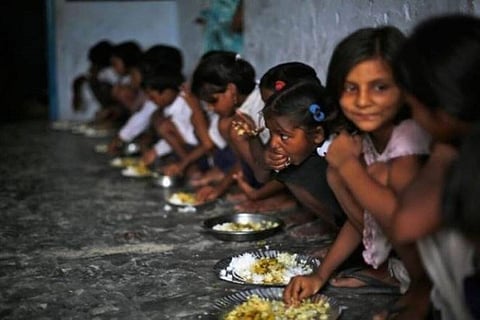

New Delhi
As per the index compiled by Global Hunger Report, Concern Worldwide and Welt Hunger Hilfe, which tracks hunger and malnutrition globally, 18 nations including China, Kuwait and Brazil have shared the top rank with a GHI score under 5.
The four indicators of this index are undernourishment, child wasting (kids under 5 with low weight as per height), child stunting (kids under 5 with low height as per age) and child mortality (mortality among kids under 5). Child wasting, a reflection of acute under-nutrition, is a concern in India, and the share of wasting among children has risen from 17.1% between 1998-2002 to 17.3% between 2016-2020.
A big share of the blame has been placed on pandemic-induced lockdowns in India. The impact of the migration of millions of workers was felt by their families who had been rendered homeless and had to traverse thousands of kilometres in the absence of food and were in turn reliant upon the goodness of Samaritans. The Centre issued a rebuttal to the report last week stating that the estimates released by the report were devoid of facts.
The Union Ministry of Women and Child Development added that the report does not mention food support received from the government, including the Pradhan Mantri Garib Kalyan Anna Yojna and Atma Nirbhar Bharat Scheme. The Centre’s reputation might seem like a moot point as the National Family Health Survey (NFHS 2019-20) about 22 Indian states shows that in the past five years, more than 50% of states witnessed a spike in child stunting and over two-thirds spike in child wasting.
These reports are emerging at a time when the Centre and those involved in putting food on our tables, the farmers, have been locked in a year-long battle over the farm laws which the latter belief goes against their interests.
It’s also noteworthy that India has 84 billionaires on the Forbes list, and one per cent of its population owns 50 per cent of the nation’s wealth. Experts believe malnutrition can be tackled by feeding children more animal-sourced and Vitamin A-enriched food items. Enabling the ownership of livestock and participation in the Centre’s Integrated Child Development Services (ICDS) programme could also go a long way in promoting dietary shifts.
As per WHO, breastfeeding has a major role to play in the nutritional development of children. However, as half of the pregnant women in India, from the ages of 15-49 (as per WHO estimates) are anaemic, the probabilities of passing on nutrients to infants are affected considerably.
A silver lining is an intervention employed by Tamil Nadu in arresting the occurrence of malnutrition. Pan-India, it is the first state that kick-started its TN Integrated Nutrition Project in the 1990s to cover the 0-5 age group. It was later merged with the ICDS. The holistic 1,000-day nutrition programme for newborns is also helping TN stay ahead of the curve in controlling malnutrition, with the lowest rates of stunting in India, alongside Goa and Kerala.
The mid-day meal scheme, in which TN has been a pioneer, also saw the introduction of daily egg-based meals to students, and it has now been rechristened as PM Poshan. It was recently announced that 24 lakh students in pre-primary classes covered under ICDS across India will now be brought under this scheme. Currently, 11.8 crore students avail of the benefits of mid-day meals. The price rise in essentials like fruits and vegetables also must be addressed. Bottom line: we need to get to a point when a serving of apples becomes more affordable than picking off a pack of wafers from a supermarket shelf.
Visit news.dtnext.in to explore our interactive epaper!
Download the DT Next app for more exciting features!
Click here for iOS
Click here for Android